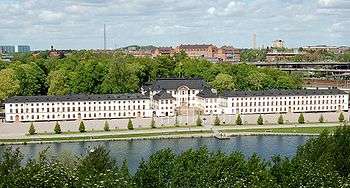Swedish Fortifications Agency
The Swedish Fortifications Agency (Swedish: Fortifikationsverket, FortV) is a Swedish government agency under the Ministry of Finance , tasked with managing government-owned defense-related buildings and land. The agency functions as the landlord for the Swedish Armed Forces (Försvarsmakten), managing various types of military installations.[7][8] The SFA is one of the largest holders of real estate in Sweden.[7]
| Fortifikationsverket | |
 The coat of arms of the Swedish Fortifications Agency | |
| Agency overview | |
|---|---|
| Formed | 1994[1] |
| Preceding agency |
|
| Jurisdiction | |
| Headquarters | Kungsgatan 43, 631 89 Eskilstuna[2] |
| Employees | 640 [3] |
| Annual budget | Self-sufficient through fees.[4] Revenue 3.0 billion SEK(2008)[5] |
| Minister responsible | |
| Agency executive |
|
| Parent agency | Ministry of Finance[7] |
| Website | www |
Function in the government
The formation of the SFA in 1994 was part of the Swedish government effort to increase the cost-efficiency of government real estate usage through a system of internal rent, which was meant to emulate market-like conditions.[9] The main purpose with the reform was to create economic incentives for the authorities in the public sector to economise on premises.[10] In the defense sector, the real estate holdings were transferred from the Swedish Armed Forces — the user of the real estate — to the SFA; with the Swedish Armed Forces remaining in the estate as a tenant.[9]
Currently, the SFA acts as landlord for several Swedish government agencies in the defense sector.[11] The main tenant is the Swedish Armed Forces, which in 2007 was the source of over 90% of the SFA:s revenue.[11]
Economy
The SFA does not receive an allowance from the government budget.[4] Instead, it covers its expenses by charging rent for the real estate it leases.[4] In 2008, the agency's revenue was 3.0 billion SEK, and its net income 67 million SEK.[5] The rent is adjusted so that the net income — which goes into the state treasury — conforms to a predefined level of return on equity, as set by the Ministry of Finance.[12] To finance investments, the SFA borrows money from the National Debt Office (Riksgälden), which acts as the internal bank of the government.[13]
Personnel
The SFA employed 689 people in 2008.[3] The majority of the employees work on a local level in real estate units linked to garrisons,[14] where employees work in areas such as project management, property development and maintenance services.[15] At the regional and national level, employees work in real estate purchasing and sales, defense facility development, and various management functions.[15] The SFA considers its core competencies to be security and protective technology.[16] The agency has stated that it aims to increase the amount of outsourcing, and as an experiment in 2006, it outsourced the property maintenance of two garrisons.[17]

Real estate stock
In 2008, the book value of the government real estate stock managed by the SFA was 10.1 billion SEK,[19] largely consisting of depots, garrisons, training facilities, offices, and proving grounds.[20] In 2007, the total real estate stock included:[21]
Notes
- Swedish Fortifications Agency: "Archived copy". Archived from the original on 2007-07-08. Retrieved 2009-07-11.CS1 maint: archived copy as title (link)
- "Kontakt" (in Swedish). Swedish Fortification Agency. Retrieved 2019-07-28.
- "Om oss" (in Swedish). Swedish Fortification Agency. Retrieved 2019-07-28.
- Ministry of Finance 2009, p. 5.
- Swedish Fortifications Agency 2008, p. 38.
- "Fortifikationsverkets styrelse" (in Swedish). Swedish Fortifications Agency. Retrieved 2019-07-28.
- Ministry of Finance 2009: "Archived copy". Archived from the original on 2009-06-07. Retrieved 2009-07-11.CS1 maint: archived copy as title (link)
- Holmström 2008
- Swedish Agency for Public Management 2004, p. 5-6
- Lind 2005
- Swedish Fortifications Agency 2007, p. 12.
- Ministry of Finance 2009, p. 1.
- Ministry of Finance 2003
- Swedish Fortifications Agency 2008, p. 7.
- Swedish Fortifications Agency: "Archived copy". Archived from the original on 2009-08-28. Retrieved 2009-07-11.CS1 maint: archived copy as title (link)
- Swedish Fortifications Agency 2008, p. 5.
- Swedish Fortifications Agency 2007, p. 8.
- Swedish Fortifications Agency: "Archived copy". Archived from the original on 2008-04-22. Retrieved 2009-07-19.CS1 maint: archived copy as title (link)
- Swedish Fortifications Agency, p. 39.
- Swedish Fortifications Agency 2007, pp. 18, 20.
- Swedish Fortifications Agency "Archived copy". Archived from the original on 2007-07-08. Retrieved 2009-07-11.CS1 maint: archived copy as title (link)
References
- Ministry of Finance (2007). "Förordning (2007:758) med instruktion för Fortifikationsverket" [Ordinance (2007:758) with regulations for the Swedish Fortifications Agency]. Svensk Författningssamling (in Swedish). Sveriges Riksdag. Retrieved 10 July 2009.
- Swedish Fortifications Agency (2009). "Official webpage" (in Swedish). Retrieved 10 July 2009.
- Ministry of Finance (2009). "Official webpage" (in Swedish). Regeringskansliet. Retrieved 11 July 2009.
- Ministry of Finance (2009). "Regleringsbrev 2009" [Appropriation directions 2009] (PDF) (in Swedish). Regeringskansliet. Retrieved 11 July 2009.
- Swedish Fortifications Agency (2008). "Årsberättelse 2008" [Annual report 2008] (PDF) (in Swedish). Retrieved 11 July 2009.
- Swedish Fortifications Agency (2007). "Årsredovisning 2007" [Annual financial report 2007] (PDF) (in Swedish). Retrieved 12 July 2009.
- Swedish Fortifications Agency (2007). "Årsfakta 2007" [Yearly facts 2007] (PDF) (in Swedish). Retrieved 12 July 2009.
- Holmström, Mikael (2008). "Myndigheter och nya förband hotas" [Government agencies and new military units endangered] (in Swedish). Svenska Dagbladet. Retrieved 12 July 2009.
- Ministry of Finance (2003). "Nya principer vid utformning av statsbudgeten" [New principles in forming the government budget] (pdf) (in Swedish). Regeringskansliet. pp. 141–142. Retrieved 12 July 2009.
- Lind, Hans; Ted Lindqvist (2005). "Real estate management in the Swedish public sector". Journal of Corporate Real Estate. Emerald Group Publishing Limited. 7 (2): 178–190. doi:10.1108/14630010510812594. ISSN 1463-001X.
- Swedish Agency for Public Management (2004). "Hyressättning och kapitalkostnader för försvarsfastigheter" [The setting of rent and the cost of equity in defense related real estate] (PDF) (in Swedish). Swedish Agency for Public Management. Retrieved 17 July 2009.